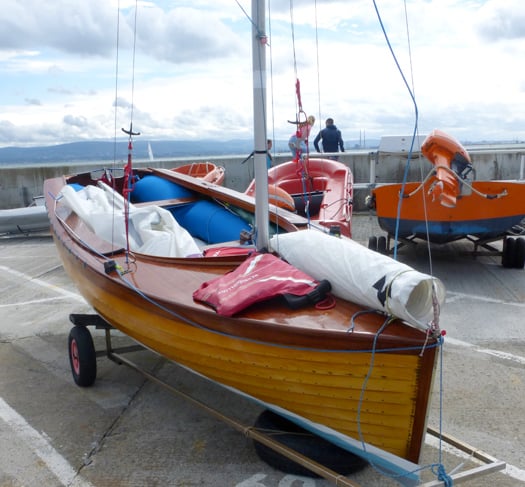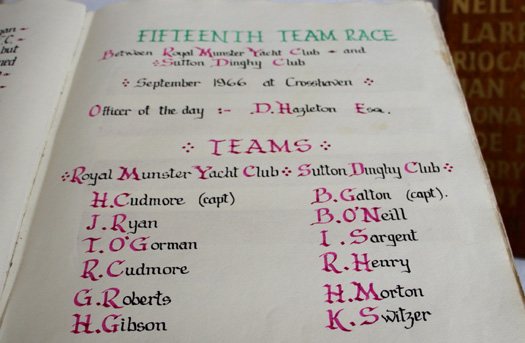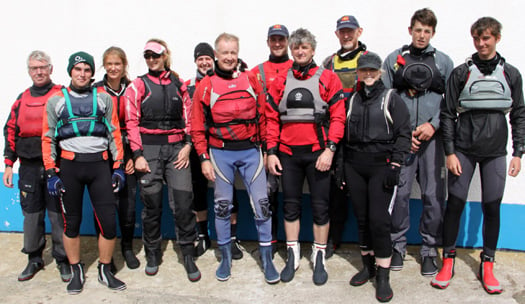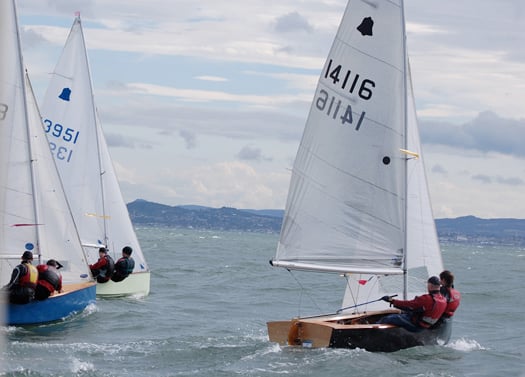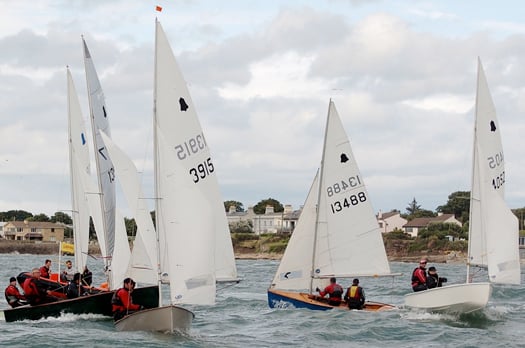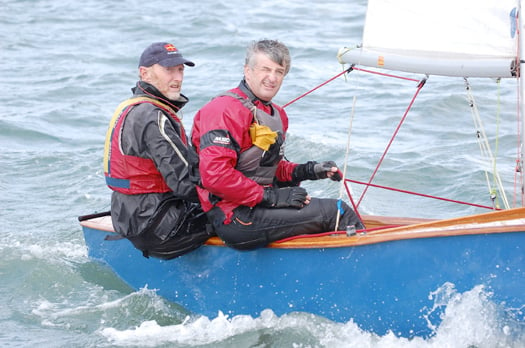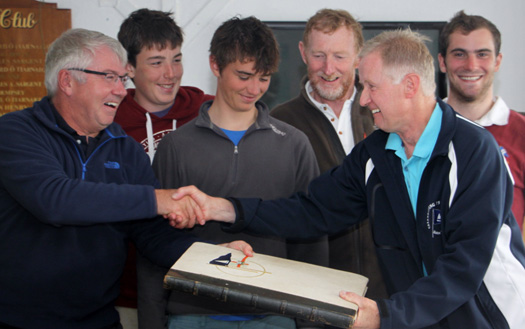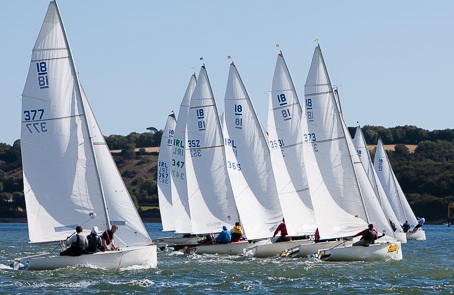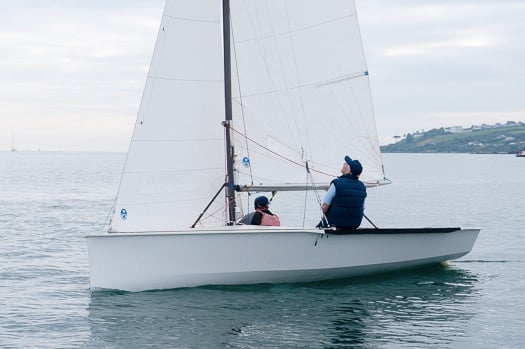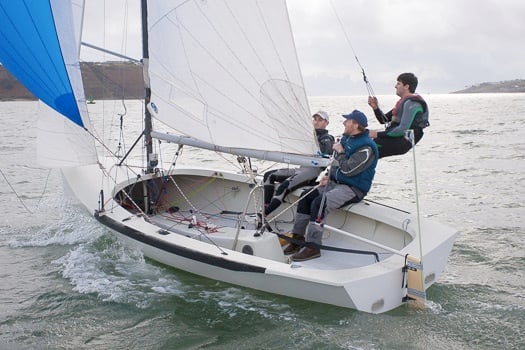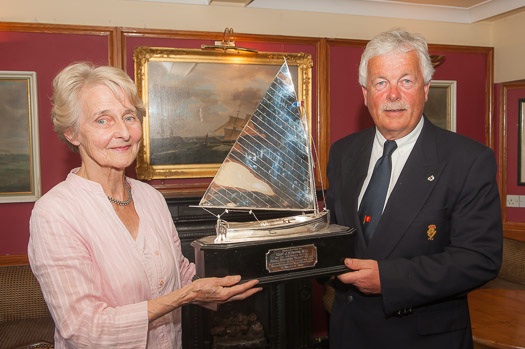If you've ever team-raced for "The Book" between Sutton Dinghy Club and a team from Cork Harbour, then you'll know that it is Irish sailing's Book of Kells, inaugurated seventy years ago with the winning team obliged to inscribe the outcome on vellum in illuminated style. W M Nixon found that this year's event last Sunday had the Corkmen celebrating a win, even if they lost the race.
Keeping the records of sporting events may seem the simplest thing in the world, but it's amazing how quickly the written reports can disappear completely. In this blog on 12th April, we were pointing out that ancient sailing trophies are doubly valuable, as they'll still be in existence and lovingly cared for because of their intrinsic worth as pieces of silverware, and with any luck they'll also carry the name of the boats and owners, the early winners of races back in those remote mists of time.
Yet even the world's oldest original sailing trophy, the Ladies Cup of Sligo Yacht Club which dates back to 1822, took a while to cop on to the need to inscribe the names. It didn't occur until 1831, when the winner was Owen Wynne of Hazelwood on Lough Gill, that lovely lake where the Sligomen sailed before they took to the sea at Rosses Point.
Because of this understandable omission – after all, everyone who was anyone in Sligo in the 1820s would have known know who was the current holder of the Ladies Cup – the oldest sailing trophy with a winner inscribed wasn't an annual challenge cup, it was a one off, the Cork Harbour Regatta Cup for 1829. The winner was J Caulfield Beamish with his cutter Little Paddy, which he designed himself. It's a thoughtful experience to contemplate this old trophy, and realize it was once handled by one of the greatest if largely unsung pioneers of Irish sailing.
But beyond the fact of who won, we know little enough of the event in 1829. And as sailing developed down the years, a plethora of events meant that the records became confused, or else there was so much data that nobody took any notice any more.
Enter the International 12ft dinghy, a simple little lugsail rigged clinker-built classic wooden boat. She was designed by George Cockshott of Southport in Lancashire in 1912, and seems to have been an instant success with the approval of the Boat Racing Association, a sort of precursor of ISAF. Fleets sprung up anywhere that sailing took place, though the class soon faded in England where newer designs appeared in the 1920s and '30s. But today, there are thriving groups of International 12s in The Netherlands, Belgium, Italy and Japan, while in Ireland they were quite the thing until 1950.
One good reason for this was that Ireland produced an International 12 superstar, Captain Jimmy Payne of Cork Harbour, who won the World Dinghy Championship racing International 12s in Belgium in 1924, the first time the new Irish Free State had competed in a sailing event in its own right. This meant that the return series for the crews from France, Holland, England, Belgium and Italy came to race against Ireland at the Royal Munster YC in Crosshaven in 1925. This time round it went down to the last race, which Jimmy Payne won by 29 seconds from Bokre of Holland, and his prize was a truly magnificent silver model of an International 12.
The International 12s were also popular around Dublin, particularly on the north side of the Bay where they either sailed from Howth or, when the tide suited, at Sutton Creek. There was only one club on the peninsula at the time, Howth SC, which sent forth an International 12 helmed by Harry McCracken to sail in the Tailteann Games in 1932, and he won the gold medal.
With International 12 sailors of this calibre in both Cork Harbour and around the Howth peninsula, there were links between the two class centres. But it wasn't until 1940 that Sutton Dinghy Club came into being beside the tidal creek. Then in 1944 an inter-club competition was inaugurated in International 12s between SDC and the Cork Harbour Sailing Club, whose young dinghy-oriented sailors with their International 12s included several people who were later to be big achievers in major clubs.
The innovative trophy for the new series was a large vellum book, the pages blank and awaiting inscription. There may well be other inter-club sailing club competitions whose perpetual trophy is an inscribed book containing the record of each annual race, but we don't know of them. Yet the continuing existence of The Book has been so central to a golden thread of sailing in Crosshaven and Sutton that those who have been involved tend to assume that everyone else knows all about it.
The Book (senior version from 1944) and the junior (from 1980) on display at Sutton Dinghy Club for Sunday's 70th Anniversary series. Photo: W M Nixon
Perhaps they do, but this year being the 70th Anniversary, it went slightly more public anyway, with Commodore Andy Johnston and his members at Sutton DC moving mountains to make it happen in a busy season in which, every other year, the race for The Book has to be slotted into a crowded annual programme and the additional need to fit the tidal window for sailing in Sutton Creek.
Over the years, The Book has stayed the same, and it's still the same Sutton Dinghy Club, albeit in larger premises. But Cork Harbour Sailing Club – whose members had been helped in their sailing by Jimmy Payne himself, who also raced for The Book – was wound up in 1950, and its membership largely subsumed into the Royal Munster in Crosshaven, which in turn became the Royal Cork for the Quarter Millennium in 1970.
Over the years, Irish sailing classes which have seen people emerge from the testing and training ground which is the racing for 'The Book' include Olympic boats such as the Flying Dutchman and the Tempest, the famous 505s, many offshore racing fleets, Fireballs, 470s, Lasers, 1720s, SB20s, Etchells 22s, Puppeteer 22s and J/24s, to name only a few. In all, it's an extraordinary list, linked by their connection to sailors from this unique event.
The historic International 12 restored by Aidan Henry of Sutton. Photo: W M Nixon
For many years, The Book was raced for in IDRA 14s, and this restored gem shows off her elegant lines at Sutton. Photo: W M Nixon
As for the gallant little International 12s, they were shunted aside in favour of IDRA14s in 1950. But there was a sweet reminder of the little boats at the 70th anniversary event on Sunday with a beautifully restored version brought back to life by Aidan Henry of Sutton, while also there was a lovingly-maintained and historic IDRA 14. Over the years, classes used have further changed, and for a while all the Cork-based races for The Book were sailed in Enterprises, while a Junior Book inaugurated in 1980 tended to favour Mirrors.
Boats may change and people move on, but The Book has remained as an extraordinary record of personal history and sailing development. The first series in 1944 was well won by Sutton, but over the years the balance has tilted in Cork's favour with 26 wins to Sutton's 18, while there have been two draws and 23 no races resulting from some weekends of total gale and other more grisly reasons - in 1956, it was the polio epidemic.
Grim reminder of times past – the terse entry in The Book for 1956 Photo: Ron Maher
Of that first Cork team of 1944, happily the great Joe Fitzgerald is still with us, and he subsequently sailed on winning teams. As you work your way through the handsome big pages, the names cascade down the years, so much so that just about every sailor of significance from Cork Harbour or Sutton (and sometimes Dublin Bay generally) has been racing for The Book.
The teams and Race Officers at Sutton in 1944 – Joe Fitzgerald of Cork is third from the right in the front row.
Royal Cork won in 1966 with a stellar team
Sutton's Ian Sargent and Royal Cork captain Harold Cudmore with The Book and their teams in 1966
These days, the Sutton sailors favour GP 14s, while for many years now the National 18s have been the heart and soul of Crosshaven sailing. This is so much the case that last year the Crosshaven class produced a fine book by Brian Wolfe not just of its history in Cork Harbour since 1939, but about the story of the National 18 at all its class centres through England, Wales, Scotland, Ireland and the Isle of Man.
Both the GP 14s at Sutton and the National 18s at Crosshaven are having a busy season throughout 2014. But it was noticed that while the cream of the Crosshaven class would be at the British & Irish National 18 Championship in Abersoch in North Wales from July 28th to August 1st, the top GP 14s at Sutton would not be heading away for their Worlds at East Down YC on Strangford Lough until Friday August 8th. There was a tiny window of opportunity on Bank Holiday Sunday, August 3rd, when the paths might be made to cross and the tide suited in late afternoon. So they grabbed it, and Sutton Dinghy Club readied up six evenly-matched GP 14s in a very focused frame of mind, as they hadn't won The Book in sixteen years.
These National 18 sailors from Crosshaven certainly are keen. Despite having raced a gruelling week in Abersoch with the National 18s, Tom Crosbie, Barry O'Meara and Tom Dwyer were ready and willing to race GP 14s for The Book just a day later. Photo: W M Nixon
The two teams for the 70th Anniversary of racing for The Book – Tom Crosbie (left) is Cork captain, while Hugh Gill (centre) captained Sutton. Photo: Ron Maher
At first, conditions looked reasonably promising, but fast moving clouds south and north.............Photo: Andy Johnston
....gave every indication of stronger winds to come. Photo: Andy Johnston
Downsizing from an 18-footer to a 14-footer was gallantly accepted by Cork crew Tom Dwyer and Barry O'Meara. Photo: Andy Johnston
After a week of hard racing off Abersoch, the Corkmen could have been forgiven for wishing only to head on home for a rest, but they're great sportsmen, they were determined to give it their best shot. However, for people down-sizing from a three man 18 footer to a two man 14 footer just for one afternoon's team racing, the conditions were cruel, with a squally west to southwest wind, and a fast-changing sky which promised more to come.
It duly delivered. They managed the first race with the teams even at first, but then Hugh Gill of Sutton sailed Patrick Crosbie of Crosshaven away from his lead over the next Sutton boat, and that changed the table just enough to have Sutton ahead by one point after one race. And that was the end of it. The wind rose well up into the 30 knot zone, there were four capsizes and one dismasting, and The Book for its 70th Anniversary went to Sutton Dinghy Club after a gap of sixteen years.
Tom Crosbie (left) returns The Book to Sutton's Hugh Gill after a 16-year run. But next year's racing will be in Cork in National 18s......Photo: Ron Maher
Yet everyone was delighted with the day. While the team racing tactics may have been cut-throat, the sport was great, and you could have run a string of bright lights off the camaraderie, with Dommo Long, the father of the National 18s, still much involved, although it's a report in The Book from very long ago which records how he kept all Sutton entranced with the post race party until six o'clock in the morning.
The National 18s as they are today. Photo: Bob Bateman
Testing the water. Father of the Class Dommo Long has an approving trial sail on the new National 18 last Autumn. Photo: Bob Bateman
Next year, of course, it will be an away match for the Sutton crews. And who knows, but they may be able to race in the brand new National 18s, a Cork-inspired concept which has been coming along very nicely, and is set to become Ireland's hottest "new" class in 2015, which goes some way to explain why the Cork men arrived in Sutton in such good form.
We ran a story in Afloat.ie about the Phil Morrison-designed prototype sailing at Crosshaven last Autumn, the boat having been cleverly developed through outside sponsorship so the €65,000 development cost didn't make a dent in the class funds. But a prototype is one thing, getting it accepted by the class association and into production is something else altogether, and everything would hinge on how the mood went at the championship in Abersoch, which would also see the crucial AGM.
Afloat, everything went fine for the Corkmen. Stuart Urquhart of the Scottish fleet may have had a good lead in the early stages, but by the finish the 2014 Champion was Ewen Barry of Cork crewed by Dion Barrett and Stan Browne. In runner up place was another Cork helm, Colin Chapman (who has played a leading role in the moves towards the new design), crewed by Bobby Bearla and Morgan O'Sullivan, while initial leader Urquhart was back in third.
The new Odyssey National 18 looks the business for speed..... Photo: Bob Bateman
......and she retains the basic seamanlike features of the established National 18s. Photo: Bob Bateman
The new boat Odyssey was out sailing and showing fabulous performance, so minds were concentrated mightily for the main formal business which came on Thursday July 31st, the 2014 AGM and the acceptance or otherwise of the new design. The National 18 is a restricted class, so in theory any new design which complies with the rules should be accepted. But the days are long gone when cheque-book sailing affected the class – if it ever did – so a significant majority would be needed to be in line with the spirit of the class, which has always favoured design development, but at a measured pace.
The vote was better than a significant majority – it was overwhelmingly in favour. Exciting times lie ahead, and no more so than in Cork. Twelve deposits have already been put down on new boats to the Odyssey design, and eight of those have come from the Cork Harbour fleet.
There's no doubt the new Morrison boat is a gorgeous bit of kit which is a delight to sail, and if you doubt this, I've been told to say that Dommo Long says so. Already, the class is rejuvenating around Cork Harbour, and though there are bound to be growing pains, you need to experience the sheer joy in sailing and the camaraderie of a handsome big three-man boat to understand the extraordinary sense of community which the National 18s engender in the special RCYC context.
In the final analysis, these people are sportsmen who sail for fun, and their dedication and enthusiasm is a joy to behold. They're respectful of the past, yet excited about the future. And the spirit of Jimmy Payne and the International 12s lives on, not least in the fact that the supreme overall prize for the National 18s in Cork Harbour is now the silver International 12 trophy which he won back in 1925.
In 2011, Mrs Eithne Payne presented the International 12 trophy, won by her father-in-law Captain Jimmy Payne in 1925, to RCYC Admiral Peter Deasy to become the season-long overall winner prize for the National 18 Class on Cork Harbour. Photo: Bob Bateman






























